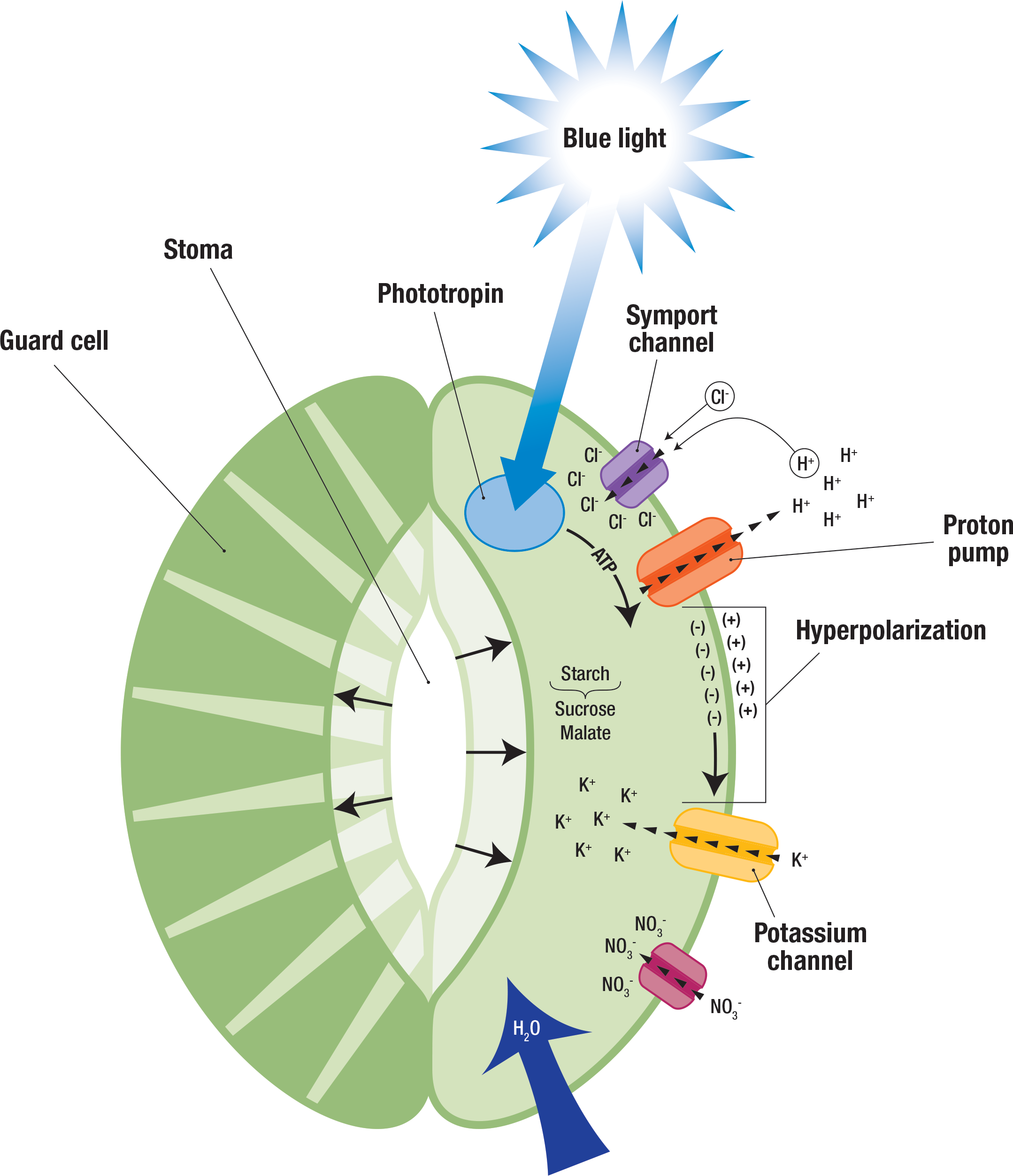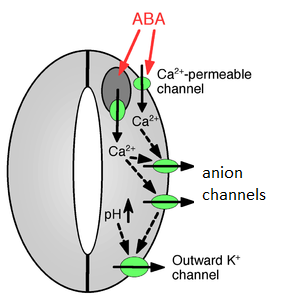2.Plant Physiology
2.2 Transpiration
Transpiration
Dr V Malathi
Transpiration is the loss of water from plant in the form of water vapor. About 97-99% of water absorbed by a plant is lost through transpiration ,mainly from the stomata in leaves and also through evaporation from the surfaces of leaves, flowers, and stems.
Stomata
The stomata are apertures in the epidermis, each bounded by two guard cells. In Greek, stoma means “mouth”, The plural of stoma is stomata. Stomata occur in Vascular plants, gymnosperms and angiosperms.
The stomata are commonly seen on green aerial parts of plants, particularly on the upper and lower sides of leaves, on flower petals, on stems, and on roots. Stomata are also found on stamens and gynoecia.
The stomata connect the inner air space of the plant cells with the atmosphere. The stomata is the major route for gaseous exchange, The stomata helps to bypass the impermeable cuticle that forms on the outer epidermal surface.. The stomatal aperture leads into a substomatal intercellular space . This is called the substomatal chamber and is continuous with the intercellular spaces in the mesophyll.
Stomata respond both to the environmental and as well as endogenous signals such as the chemical and hydraulic signals by opening and closing the pore.
It thereby regulates both photosynthesis , regulating the CO2 entry as well as transpiration by limiting the water loss.

“Stomata” by CNX OpenStax, is licensed under CC BY 4.0
Stomatal Opening and Closure
Stomatal Opening
The guard cells are a pair of bean or kidney-shape control the size of the stomatal aperture by changing their shape.
During extreme weather conditions such as high CO2 levels, O3, low air humidity, and drought, the turgor pressure of the guard cells exhibits an appropriate response against these stresses and closes the stomata. This phenomenon involves a complex network of ion channels and their regulation.
When turgor pressure increases in guard cells, the cells swell but the thickened inner walls of the guard cells near the stoma cannot expand and as a result they curve to accommodate the expanding outer walls. This curving of the guard cells opens the stoma
What is the role of light in the opening of stomata?
Light-induced stomatal opening can be divided into two different pathways, including the red light responses and blue light responses.
Distinct wavelengths of solar irradiance are detected by multiple plant photoreceptors
These include :
- blue/ultraviolet-A absorbing cryptochromes (CRY1/2) and phototropins (PHOT1/2),
- red/far-red absorbing phytochromes (PhyA-E), and
- ultraviolet-B absorbing photoreceptor UVRESISTANCE LOCUS 8
PHOT1 and PHOT2 are the major blue light-specific photoreceptors in guard cells modulating stomatal movement.
Guard cells use ATP, generated by light reaction s of photosynthesis to drive H+ out of the cell via H+-ATPases,
This generates a membrane voltage, negative inside, and an electrochemical potential difference
The cytosol usually more negative than the extracellular solution,
This difference in charge (membrane potential) increases as protons leave the cell and is called hyperpolarization.
It causes the movement of potassium (K+) down its electrochemical gradient into the cytosol.
Further through the symport channels protons also move down their electrochemical gradient back into the cytosol along with chloride (Cl–) ions.
Meanwhile, starch is broken down, producing sucrose and malate. Nitrate (NO3–) also enters the cell.
The solute potential resulting from high concentrations of potassium, chloride, sucrose, malate, and nitrate in the cytosol drives the osmosis of water into the the guard cells which increases turgor pressure of the guard cells .
The guard cells as a consequence expand and bend, opening the stoma
In general when the osmotic pressure of the guard cells became greater than that of the surrounding cells, the stomata is opened.
In the evening, when the osmotic pressure of the guard cells dropped to nearly that of the surrounding cells, the stomata closed.

“Guard cells” by Jen Valenzuela is licensed under CC BY-NC 4.0
Stomatal Closure
When water is low, roots synthesize abscisic acid (ABA),
Xylem conducts ABA to the leaves.
In the leaves abscisic acid causes calcium channels to open.
Calcium (Ca2+) opens anion channels and as a result malate, chloride, and nitrate exit the cell.
The membrane potential decreases as anions leave the cell and is called depolarization
Potassium exits the cell in response to this depolarization.
The loss of these solutes in the cytosol results in water leaving the cell and a decrease in turgor pressure.
The guard cells regain their original shape, and the stoma closes

“Guard cells” by June Kwak is in the Public Domain, CC0
Stomatal transpiration accounts for between 50-97%of total transpiration.
Though stomata make up only 3% of the leaf surface area most water loss happens through these openings due to the opening of the stomata to let in carbon dioxide for photosynthesis during which the water in the mesophyll tissue in leaves evaporate if the air outside is drier due to factors like high temperature.
Cuticular transpiration
The leaf surface has a waxy cuticle through which water vapor can evaporate.
Water loss here is lower compared to stomatal transpiration,
The cuticle loses roughly 5-10% of the water in the leaves.
Lenticular transpiration
Lenticels, small openings found in some plants’ bark and twigs.
Not all plants have lenticels.
The amount of water lost though lenticels is quite modest compared to stomatal transpiration.
This may rise if a plant is in a dry environment, just as in cuticular transpiration.
For Further reading and Practice
Test your Understanding of the process of Transpiration by attempting the Cross word Puzzle
Apertures in the epidermis of plant cell bounded by guard cells

